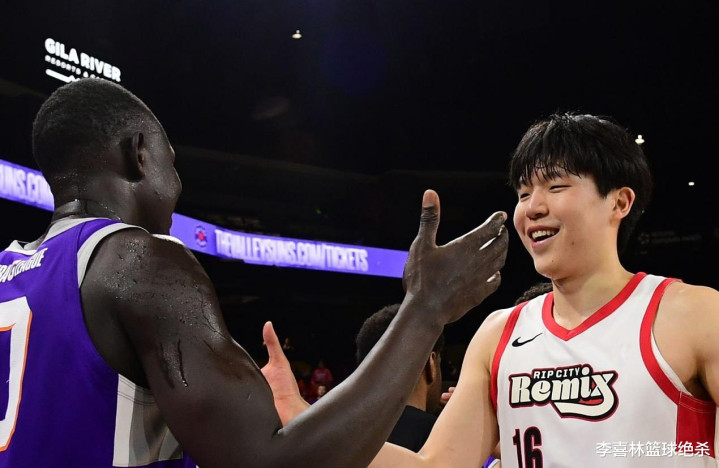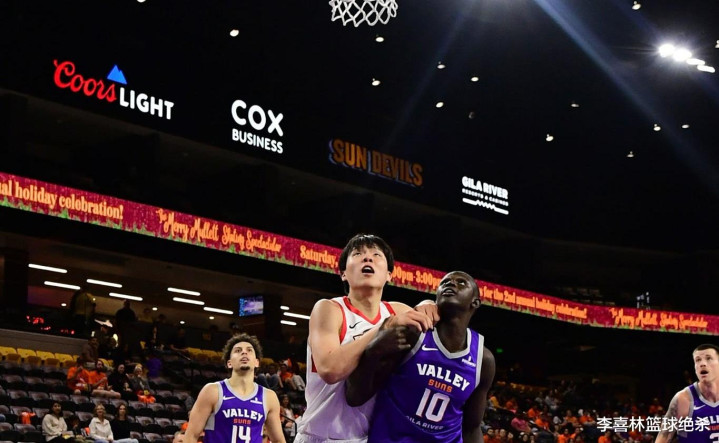Congratulations! Yang Hansen got off to a good start in the G League: he hit 8+13+4 to help the team make a big comeback, suppressing the 2.16-meter center.
Yang Hansen finally got a chance to play, but it was only in the Development League. On November 15, Yang Hansen made his Development League debut. He played 30 minutes, made 4 of 11 shots, scored 8 points, 13 rebounds, 4 assists, 1 steal and 1 block, helping the Torn City Mix reverse the Valley Suns 107-104. Yang Hansen first suppressed and then improved in this battle. In the first half, he adapted to the rhythm. In the second half, he used passing, rebounding and defense to help the Mix team complete a great reversal. In the NBA arena, Yang Hansen has been ignored by coach Split for a long time. Now he needs to concentrate on leveling up in the Development League. For Xiao Yang, this is a very good start. The duel between Yang Hansen and good brother Maluachi is a highlight. Both are players under Rich Paul and both are this year's lottery picks. Maluachi, who is 2.16 meters tall, was selected by the Suns with the 16th pick in the first round. Maluacchi and Yang Hansen share the same fate. The Suns also have many centers with good strength. Currently, Maluacchi can only be in the fourth center position, and it is difficult to get playing time, so he can only be sent to the Development League for leveling. The top three players at the Suns center position are Mark Williams, Nick Richards and Iguodaro. In this battle, in the duel between Yang Hansen and Maluach, Maluach was dominant in the first half, and Yang Hansen was dominant in the second half. Overall, Yang Hansen had the upper hand. Tear City Mix performed poorly in the first half. At halftime, Mix was 20 points behind 39 to 59. Yang Hansen played 13 minutes in the first half, making 3 of 9 shots, 0 of 2 three-pointers, 6 points and 5 rebounds, 2 turnovers and 2 fouls, with a plus-minus value of -25, the lowest in the game. Maluachi made 2 of 3 shots and scored 7 points, 1 rebound, 2 assists, 2 steals and 2 blocks. Obviously his performance was better than Yang Hansen. Yang Hansen played the role of offensive terminator in the first half and did not use his strengths. In the second half, the Mixed Team adjusted Yang Hansen's role arrangement and gave him the task of organizing the offense, with him acting as one of the initiators of the offense. Yang Hansen returned to his best role, creating many scoring opportunities for his teammates through passes at the top of the key. In the third quarter, he sent out consecutive assists and scored himself. Yang Hansen scored 2 points, 3 rebounds, 3 assists and 1 steal in the third quarter, and the Mix team narrowed the gap 37-28. The morale of the Mixing team was greatly improved and they continued to chase points in the fourth quarter. The Mixed Team controlled the tempo of the game and gradually overtook the score. Yang Hansen's plus-minus value made up for the deficit in the second half, from -25 in the first half to 0. Yang Hansen in the second half was what the Blazers wanted to see. Yang Hansen grabbed 13 rebounds, the highest in the game, including 5 offensive rebounds. One of Yang Hansen's weaknesses that was exposed in the preseason and regular season was his rebounding ability. In contrast, Klingen and Lowe have strong rebounding abilities. Reese has a three-point shot and moves relatively quickly. Yang Hansen at least showed a strong desire to rebound in this battle. Especially in the second half, he had the upper hand in the rebound battle with Maluachi. Judging from this game, Yang Hansen's physical fitness, confrontation and rebounding have all made progress. In other words, this period of training was not in vain. Yang Hansen temporarily lost his chance to play in the NBA. He was previously sent to the Development League for training by the Trail Blazers. Now he is starting to compete in the Development League with the Mix team. For Yang Hansen, serving as the starting center in the mixed team and playing for about 30 minutes shows that the team is cultivating him. Yang Hansen also needs the opportunity to practice in the Development League. In fact, many starting players in the NBA started in the Development League in their early years. Jaylen Johnson, who has shown great power in the Hawks recently and is known as the "New Eagle King", was only a marginal player for the Hawks in his rookie season. He averaged 5.5 minutes per game and only scored 2.4 points and 1.2 rebounds. He spent most of his time in the Development League. But now Jaylen Johnson has transformed into an all-around warrior, averaging 21.5 points, 9.5 rebounds, 6.3 assists and 1.8 steals per game this season. The role model Yang Hansen should follow most is Thunder center Hartenstein. Harten was selected by the Rockets with the 43rd overall pick in 2017. He played in the Development League for the entire 2017-18 season and did not receive an NBA contract from the Rockets at that time. Hatten worked hard and played 38 games in the Development League, averaging 9.5 points, 6.6 rebounds and 1.1 blocks per game. In the summer of 2018, he received a three-year contract from the Rockets and only then began to officially play NBA games. Harten moved forward step by step. After several twists and turns, he became the starting center in the Knicks. In the summer of 2024, he received a three-year, $87 million contract from the Thunder. He also helped the Thunder win the championship last season and became a championship center. His market value has further increased. Everything is difficult at the beginning. Yang Hansen took the first step to level up in the Development League and got off to a good start. He has shown some progress, but he still needs to continue to work hard and improve his abilities in all aspects. 



- Recent Posts
-
- Grimes offense and defense ar
- As long as I don’t apply for a
- Valanciunas just joined the Nu
- His strong defense helped the
- Russell: I had to step up and
- The Rockets, Bulls and Knicks
- Hart: We need Towns to stay ag
- Netizen: You have to tell us w
- Eastern Magic has been upgrade
- If Pippen can lead the team to
- Hot Posts
-
- Billionaire! Yang Hansen, the
- In the first round, the Hawks
- Clippers officially announced
- NBA Draft Expert: If I were a
- A beautiful Chinese player too
- Durant joins the Rockets best,
- Yang Hansen went to Las Vegas
- Bill executes the trade veto a
- Trail Blazers coach Billups pr
- 16th pick in the first round!
- Reject the Rockets? It is reve
- Wesley Johnson, the first roun
- Only internal potential + no m
- Should the Rockets trade the N
- Jokic is unprecedented, will Y
- 5.2 million, the first choice
- FMVP ranking update: Alexander
- 50 players withdrew from the N
- Strong willingness! Durant has
- Champions League seven! Hallib
- search
-
- Links
-
